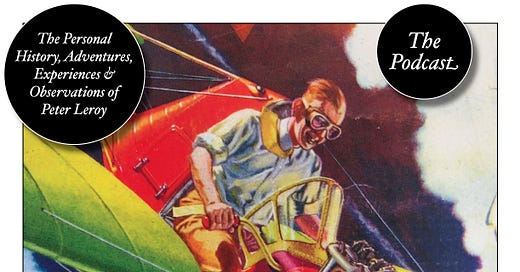There I went, into an alley I had meant to ignore. As my work on this book progressed, as I kept poking my way a bit deeper into that alley, I found that I wasn’t alone: I was being led by Margot and Martha, to a different theater, not the one on Main Street, showing a film quite different from the movie I was trying to remember—a film intended for grown-ups, never for children.
What was that film that Margot and Martha and I saw together, the one that played so important a part in our juvenile affair? It might have been Love in the Shadows or The Shadow of Love or Love Shadows or Shadowy Lovers or something like that. Since I couldn’t recall the film precisely, I fused a love story with another movie that I saw at about that time. (You may imagine me rolling another couple of pieces of blue and yellow clay into a pea-sized lump of green.) I remember the second movie well. It was about war, but not about valor and camaraderie, the stuff of the “war movies” I watched with my pals on Saturdays; this one was about death and suffering, oppression and privation, the kind of stuff that drove me from the mainland of life to Small’s Island and a life of wishful thinking. When I put the two movies together, I came up with the travesty that you will read—a movie in which three lovers manage to get themselves into a number of entanglements of legs and arms quite shocking for the time, while skittering from one dark hiding place to another, fleeing the killjoy kops of an unnamed fascist dictatorship. That film—but that’s another story, and you’ll soon be reading it. (By the way, I used the phrase “but that’s another story” liberally throughout this book because it’s so tantalizing, with its assertion that there is another story, its invitation to imagine such a story.)
I’ve just recovered another memory of that first night I spent with the twins. The film was over—was it Love’s Fleeting Shadow? Margot and Martha and I were walking through nighttime Babbington. I see now that the girls were wearing identical sailor suits, with middy blouses, short blue skirts, white sneakers, white socks, and sailor hats, as if it were still summer. (Did they have sweaters? In my mind’s eye they don’t seem to. Come into my arms, girls; you’re shivering.) Those outfits seemed too bright. They clashed with the film that I had them drag me to see, so I had to change them. Imagine Margot and Martha in slinky leotards, please, black, and add short black silk skirts, the kind called “wrap skirts” that tied around the waist and flipped open now and then as the girls walked along beside me. And, in the style of the time, sheer scarves tied at their necks. Red scarves. And berets? Black berets? Why not? Berets. Yes. That’s it.
I have to confess that I misunderstood and underestimated the girls’ parents, Andy and Rosetta Glynn, in those days. Only much later did I realize that the vague, huge, sweeping, apparently abstract curves of Andy Glynn’s paintings added up to the same Glynnscape that so enchanted me, and not until even later than that did I realize that the enchanting Glynnscape was the backdrop and inspiration for a slim volume with a long title, An Invitation to You, Girls, to Make Much of the Day, a Day, These Days, Every Day, which was the book of poems in the Persian style that I spotted on the girls’ bedside table the first night I spent with them, and I did not realize then that their mother was the “translator” of those poems—in truth their author.
I omitted from the story most of the lying, guile, and bamboozling that I sank to in order to keep my parents from knowing that I was spending my nights in such bliss, in such a haven of art and hotbed of sin. I wove a tale more tangled than this preface and story put together. I had a little talent for deception, and I put it to a shameful use. Self-serving narrator that I am, I’ve left most of that out.
[to be continued]
Have you missed an episode or two or several?
You can begin reading at the beginning or you can catch up by visiting the archive or consulting the index to the Topical Guide. The Substack serialization of Little Follies begins here; Herb ’n’ Lorna begins here; Reservations Recommended begins here; Where Do You Stop? begins here; What a Piece of Work I Am begins here; At Home with the Glynns begins here.
You can listen to the episodes on the Personal History podcast. Begin at the beginning or scroll through the episodes to find what you’ve missed. The Substack podcast reading of Little Follies begins here; Herb ’n’ Lorna begins here; Reservations Recommended begins here; Where Do You Stop? begins here; What a Piece of Work I Am begins here; At Home with the Glynns begins here.
You can listen to “My Mother Takes a Tumble” and “Do Clams Bite?” complete and uninterrupted as audiobooks through YouTube.
You can ensure that you never miss a future issue by getting a free subscription. (You can help support the work by choosing a paid subscription instead.)
At Apple Books you can download free eBooks of Little Follies, Herb ’n’ Lorna, Reservations Recommended, and Where Do You Stop? and What a Piece of Work I Am.
You’ll find overviews of the entire work in An Introduction to The Personal History, Adventures, Experiences & Observations of Peter Leroy (a pdf document), The Origin Story (here on substack), Between the Lines (a video, here on Substack), and at Encyclopedia.com.














Share this post